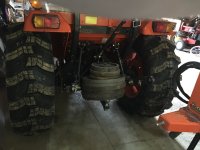gladehound
Veteran Member
"You need rear ballast or you will trash your front axle"
I just read this in another thread and have often read similar things in others. It makes sense. After all, adding weight behind the rear axle removes weight from the front axle. I've always just accepted this statement... until now.
The reason I began doubting the validity of this is because the amount of rear ballast most people use is not enough to change the weight on the front axle substantially when a heavy load is lifted. I struggle to believe that a 10% difference in weight on the front axle is going to trash it.
If you don't get what I'm saying, let me give an example:
My tractor weighs 6500 pounds with filled rears and FEL and probably has 3,000 pounds on the front axle. If I pick something up with the FEL that is 2000 pounds and it is as far in front of my front axle as my wheel base is long, it adds 4,000 pounds to my front axle for a total of 7,000 pounds on the front axle. Now, if I had a 1,000 pound ballast box on my 3pt hitch, it would be about 1/2 a wheel base behind my rear axle. As such it would remove 500 pounds from the front axle and I would then have 6500 pounds on my front axle. Even a 2,000 pound weight box would only lighten the front by 1,000 pounds. So 6,000 pounds on the front instead of 7,000 pounds.
Even the 2,000 pound weight box doesn't make a big difference in the amount of weight on the front axle. Given this, I'm beginning to doubt the claim that you will trash your front axle without a counter weight.
Interested in Thoughts and or experience with what front axles have survived or not survived. My guess is that some tractors have over built front axles and it makes little difference while other s have under built front axles that will have problems regardless of what you do. Any experiences?
I just read this in another thread and have often read similar things in others. It makes sense. After all, adding weight behind the rear axle removes weight from the front axle. I've always just accepted this statement... until now.
The reason I began doubting the validity of this is because the amount of rear ballast most people use is not enough to change the weight on the front axle substantially when a heavy load is lifted. I struggle to believe that a 10% difference in weight on the front axle is going to trash it.
If you don't get what I'm saying, let me give an example:
My tractor weighs 6500 pounds with filled rears and FEL and probably has 3,000 pounds on the front axle. If I pick something up with the FEL that is 2000 pounds and it is as far in front of my front axle as my wheel base is long, it adds 4,000 pounds to my front axle for a total of 7,000 pounds on the front axle. Now, if I had a 1,000 pound ballast box on my 3pt hitch, it would be about 1/2 a wheel base behind my rear axle. As such it would remove 500 pounds from the front axle and I would then have 6500 pounds on my front axle. Even a 2,000 pound weight box would only lighten the front by 1,000 pounds. So 6,000 pounds on the front instead of 7,000 pounds.
Even the 2,000 pound weight box doesn't make a big difference in the amount of weight on the front axle. Given this, I'm beginning to doubt the claim that you will trash your front axle without a counter weight.
Interested in Thoughts and or experience with what front axles have survived or not survived. My guess is that some tractors have over built front axles and it makes little difference while other s have under built front axles that will have problems regardless of what you do. Any experiences?
